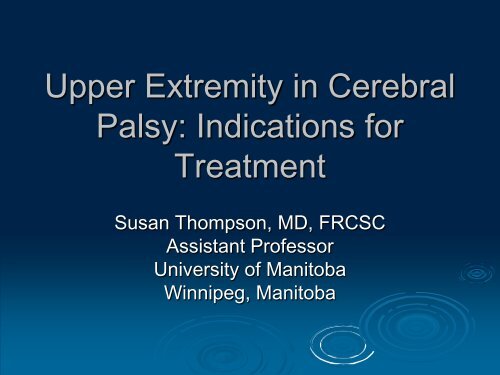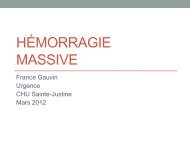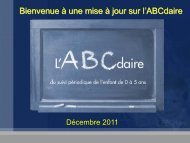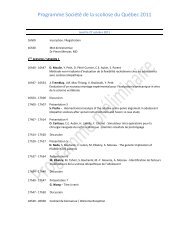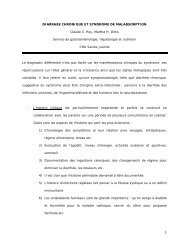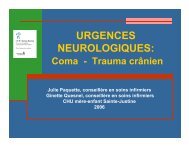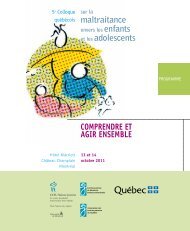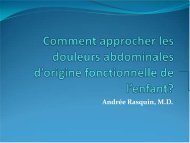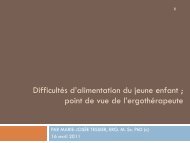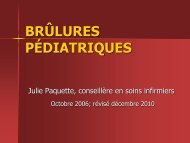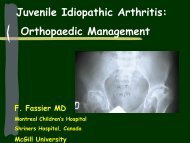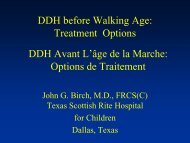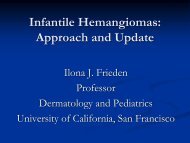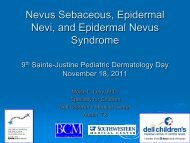Spastic Hand - CHU Sainte-Justine - SAAC
Spastic Hand - CHU Sainte-Justine - SAAC
Spastic Hand - CHU Sainte-Justine - SAAC
Create successful ePaper yourself
Turn your PDF publications into a flip-book with our unique Google optimized e-Paper software.
Upper Extremity in Cerebral<br />
Palsy: Indications for<br />
Treatment<br />
Susan Thompson, MD, FRCSC<br />
Assistant Professor<br />
University of Manitoba<br />
Winnipeg, Manitoba
Cerebral Palsy<br />
‣ Definition:<br />
• Static, non-progressive disturbance of the<br />
cerebral cortex occurring before the age of<br />
two<br />
• Results in altered motor, sensory and often<br />
intellectual function
‣ Remember:<br />
• While the brain lesion may be permanent and<br />
non-progressive, the natural history of<br />
cerebral palsy is NOT static<br />
• Growth and maturation of the central nervous<br />
system, and the whole child will cause<br />
changing musculoskeletal problems
‣ According to Manske (1990):<br />
• Only 20% of all CP surgery involves the upper<br />
extremity
‣ “traditional criteria” for surgery<br />
‣ Aimed to select those patients who will<br />
show functional improvement
Traditional Criteria<br />
‣ Assessment of:<br />
1. Voluntary hand use<br />
2. Motor function<br />
3. Sensibility<br />
4. Intelligence/ability to comply<br />
5. Athetosis/movement disorders
Voluntary <strong>Hand</strong> Use<br />
‣ Very difficult to quantify<br />
‣ Hoffer – estimated it by assessing the<br />
ability to place the hand from the head to<br />
the knee in an alternating fashion every 5<br />
seconds<br />
‣ Dependent on good shoulder and elbow<br />
control<br />
‣ Very difficult if a movement disorder is<br />
present (athetosis, ataxia, dyskinesia)
Voluntary <strong>Hand</strong> Use<br />
‣ Examine wrist and digits for voluntary<br />
flexion and extension<br />
‣ Contracture may limit movement of digits<br />
with respect to wrist position (ie wrist<br />
flexion may allow digital extension )
Grading of <strong>Hand</strong> Function<br />
‣ Green & Banks (mod: Samilson & Morris)<br />
• Poor – paperweight, poor or absent grasp &<br />
release, poor control<br />
• Fair – helping hand, no effectual use of hand,<br />
moderate grasp & release, fair control<br />
• Good – use in dressing & general activities,<br />
effectual grasp & release, good control<br />
• Excellent – good use of hand, excellent<br />
control
House Grading<br />
‣ 0 – does not use<br />
‣ 1 – poor passive<br />
assist<br />
‣ 2 – fair passive assist<br />
‣ 3 - good passive<br />
assist<br />
‣ 4 – poor active assist<br />
‣ 5 – fair active assist<br />
‣ 6 – good active assist<br />
‣ 7 – spontaneous use,<br />
partial<br />
‣ 8 spontaneous use,<br />
complete
Sensibility<br />
‣ Very difficult and unreliable<br />
‣ Need cooperative child, a certain level of<br />
intellectual capacity, and language ability
Sensibility<br />
‣ Impairment is seen in 50-90%<br />
‣ Decreased 2-point discrimination,<br />
stereognosis, and proprioception<br />
‣ Must consider the age of the child<br />
• If
Sensibility<br />
‣ Improved functional results are more likely<br />
in patients with less than 10mm 2-point<br />
discrimination, 3 of 5 object identification,<br />
or number discrimination in the palm<br />
‣ Impaired sensibility should not prevent<br />
reconstructive surgery
IQ<br />
‣ Reconstructive surgery - Contraindicated<br />
If IQ < 70<br />
‣ Is IQ testing accurate in CP<br />
‣ Is IQ important if re-education is not<br />
necessary
Athetosis/Movement disorder<br />
‣ Fluctuations in tone<br />
‣ Results of surgery are unpredictable<br />
‣ Consider fusions
Other Considerations
Timing<br />
‣ Delay surgery until a clear evaluation of<br />
functional use is possible – age 6-12 years<br />
‣ Functional improvement can be seen in<br />
older individuals after surgery
Goals & Expectations<br />
‣ Discuss expectations with patient and<br />
caregivers<br />
• Will not achieve a “normal” limb<br />
‣ Team approach<br />
• Therapists, physiatrists, pediatricians can all<br />
help determine the goals of surgery<br />
‣ Usefulness of patient questionnaire
‣ Improving function is not the only objective<br />
of surgery<br />
‣ Consider Three goals:<br />
• Improved function<br />
• Improved cosmesis<br />
• Improved hygiene
Guidelines<br />
‣ If IQ less than 50, hand placement greater than 5<br />
seconds, and poor sensibility – primary goal should be<br />
hygiene<br />
‣ If IQ greater than 50, but poor hand placement and poor<br />
sensibility – procedures to improve contracted<br />
appearance of the limb as well as hygiene should be<br />
considered<br />
‣ If IQ greater than 50, hand placement less than 5<br />
seconds, good sensibility – ideal candidate for functional<br />
improvement
Physical Examination<br />
Just a few tips!
Examination Goals<br />
‣ Evaluate spasticity<br />
‣ Evaluate motor and sensory deficit<br />
‣ Evaluate existing function and functional<br />
needs<br />
‣ Perform complete general examination to<br />
seek associated neurologic disorders and<br />
contraindications to surgery
Physical examination<br />
‣ Often difficult<br />
‣ Patient & parents can identify specific<br />
tasks that are problematic<br />
‣ Observe routine activities – note functional<br />
deficits and patterned hand movements<br />
‣ Videotaping<br />
‣ Multiple visits
Physical examination<br />
‣ Note resting position<br />
‣ Posturing<br />
‣ Strength of muscles<br />
‣ Inspect for potential<br />
hygiene problems
<strong>Spastic</strong>ity<br />
‣ Velocity dependent increase in muscle<br />
tone<br />
‣ Selective – predominant in flexor and<br />
adductor muscles<br />
‣ Usually more severe in distal part of limb
Fibrous Contracture<br />
‣ Permanent and cannot be overcome<br />
‣ In cases of severe spasticity, clinical<br />
distinction between contracture and<br />
spasticity may be extremely difficult<br />
• Consider motor block
Range of motion<br />
‣ Assess both active and passive range of<br />
motion<br />
‣ Useful to ask patient to do purposeful<br />
tasks<br />
‣ Need a range of toys, games to better see<br />
arm function<br />
‣ Therapist can be very helpful with this part<br />
of evaluation
Shoulder<br />
‣ If resting position is<br />
internal rotation<br />
• <strong>Spastic</strong>ity and possibly<br />
contracture exist<br />
• Determine if this<br />
interferes with use of<br />
UE<br />
• Usually involves<br />
adductor and internal<br />
rotator muscles
Elbow<br />
‣ Resting position – usually flexion<br />
‣ <strong>Spastic</strong>ity of biceps and brachialis<br />
‣ Possibly also brachioradialis
Forearm<br />
‣ Position at rest – usually pronation<br />
‣ <strong>Spastic</strong>ity of muscles originating from medial<br />
epicondyle<br />
‣ Active supination & pronation<br />
‣ Palpation of pronator teres during passive<br />
supination
Forearm<br />
‣ Unable to oppose hands;<br />
difficult to oppose small<br />
objects<br />
‣ Reverse grasp<br />
‣ Rarely associated with radial<br />
head dislocation – does not<br />
need to be addressed<br />
surgically
Wrists & Digits<br />
‣ Observe flexion & extension<br />
• If UD with flexion – spasticity of<br />
FCU<br />
• If UD with extension – spasticity<br />
of ECU<br />
‣ Palpate FCR to ensure it is<br />
firing (especially if considering<br />
transfer)<br />
‣ Note: UD may passively<br />
increase thumb abduction
‣ Volkman’s angle<br />
Flexor tightness
‣ FDS vs FDP tightness<br />
• When passive PIP joint extension is limited -<br />
suspect FDS spasticity<br />
• If PIP joints have full extension, but the DIP<br />
joints do not – FDP spasticity is suspected
Grasp and Release<br />
‣ Evaluate grasp and release<br />
with wrist in flexion and in<br />
extension<br />
‣ Poor grasp = weak wrist<br />
extensors<br />
• May be unable to actively<br />
extend wrist<br />
• May flex wrist when making a<br />
fist<br />
• Consider transfer to increase<br />
wrist extensor power
‣ Poor release = weak<br />
digital extensors<br />
• Unable to actively<br />
extend digits, or able to<br />
extend digits only with<br />
the wrist flexed<br />
• A transfer to extend the<br />
wrist may leave the<br />
patient unable to extend<br />
the digits<br />
• May benefit from a<br />
transfer to augment<br />
digital extension
‣ Curled or clenched<br />
into a fist<br />
‣ Swan neck or clawtype<br />
deformity<br />
‣ Occasionally<br />
Boutonniere<br />
deformity<br />
Fingers
Intrinsic tightness<br />
‣ At rest: flexion of MP<br />
joints and extension<br />
at IP joints<br />
‣ Bunnell test
Thumb<br />
‣ Thumb-in-palm deformity<br />
1. Web space contracture<br />
2. <strong>Spastic</strong>ity or contracture of<br />
APB, FPB, 1 st dorsal<br />
interosseous, spasticity of FPL<br />
with wrist flexed and extended<br />
3. Strength of APL, EPB, EPL<br />
4. Hypermobility of thumb MP<br />
joint
Additional studies<br />
‣ EMG<br />
• Surface and fine needle electrodes<br />
• Determine spastic & flaccid muscles<br />
• Determine phase of firing<br />
• Muscles found to be in phase with the<br />
recipient muscle tend to do better than those<br />
that are nonphasic
Additional studies<br />
‣ Motion laboratory analysis<br />
• Patterned movement<br />
• Efficiency (oxygen consumption)
1. FCU EDC<br />
2. BR ECRB<br />
3. EPL reroute<br />
4. Pronator rerouting<br />
5. Adductor release<br />
6. Web plasty<br />
7. Flexor lengthening<br />
8. Thumb MP fusion


